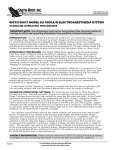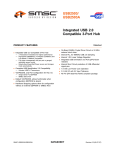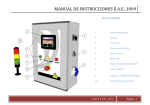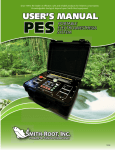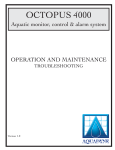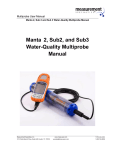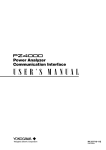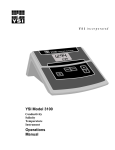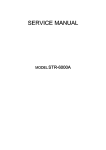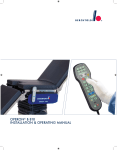Download USER`S MANUAL - Smith-Root
Transcript
USER'S MANUAL CONTENTS SYSTEM DESCRIPTION............................................. 1 OPERATING INSTRUCTIONS................................. 3 SET UP......................................................................... 4 ADJUSTING SETTINGS............................................ 5 CONTROLS & INDICATORS.................................... 6 FRONT PANEL CONTROLS.................................... 7 WIRING/MAINTENANCE........................................ 8 SAFETY CHECKLIST................................................ 9 GLOSSARY OF TERMS...........................................10 ERROR CONDITIONS...............................................11 PIN-OUTS FOR CONNECTORS............................. 12 SPECIFICATIONS..................................................... 13 APPENDIX.................................................................14 Items manufactured by companies other than Smith-Root carry the original manufacturer’s warranty. Please contact product manufacturer for return instructions. All Smith-Root, Inc. manufactured products are covered by a one year warranty. Due to increased handling costs a minimum order amount of $25.00 is required. Prices are subject to change without notice. SRI reserves the right to make changes of products at anytime without notice. Smith-Root, Inc. Electrical Field Fish Barrier systems are protected by patent. Ideas, arrangements, drawings, and specifications are the sole property of Smith-Root, Inc. and are intended for this specific catalog and shall not be used for any other purpose, without written consent of Smith-Root, Inc. U.S. - 4,750,451 Canada - 1,304,442 Credit & Refund Policy: Customers returning equipment, in new condition, will be given credit to the applicable VISA/Master Card account within five days from the date of the return. A return authorization must accompany returns. Valid equipment returns include, but are not limited to, ordering incorrect equipment, funding deficits, and defective equipment returned for reimbursement. All returns are subject to a restocking fee and applicable shipping charges. The restocking fee is figured at 10% of the purchase price but not less than $20.00. Customers receiving equipment in damaged condition will be referred to the shipping company for insurance reimbursement. Rev.005 © 2013 Smith-Root, Inc. Vancouver, WA - USA • Rev. 05 Control # 08117.05 2013 I EA-1000B USER'S MANUAL ELECTROANESTHESIA UNIT WARNING: HIGH VOLTAGE IS USED IN THE OPERATION OF THIS EQUIPMENT! DEATH ON CONTACT MAY RESULT IF PERSONNEL FAIL TO OBSERVE SAFETY PRECAUTIONS. BE CAREFUL TO AVOID CONTACT WITH ALL CIRCUIT COMPONENTS AND CONNECTIONS WHILE CHECKING OR SERVICING THIS EQUIPMENT. SYSTEM DESCRIPTION power required is 120 VAC to 240 VAC, 60 Hz single phase at 15 amps. The input Input power fuses are housed in indicating fuse holders mounted on the front panel. The polarity of the electrical output supplied by the EA unit can be switched at the front panel in order to counteract the electrical generation of deposits on the electrodes in the tank over time. The output is switched on and off by a low voltage remote control switch. Either a single or dual footswitch assembly can be connected to the receptacle on the EA unit. PROCEDURE AT A TYPICAL ELECTROANESTHESIA INSTALLATION 1 2 ELEVATOR CONTROL UNIT CROWDER CA TH OD AN E Fish are herded through crowder and into the Elevator. 3 Elevator lifts fish above electroanesthesia tank and drops them in. 4 OD E ANESTHESIA TANK The EA-1000B Electroanesthesia Unit is a high-voltage Direct Current, (DC), pulsator that puts out a complex waveform capable of anesthetizing fish placed in the treatment tank. The varying electric field first excites the fish then puts them into an anesthetized state. The electrical output of the EA unit is engineered to induce the mildest possible physiological reaction of the fish. The controls should be adjusted to anesthetize the fish quickly and deeply with the minimum power applied. The electrical output waveform is applied in two successive stages, each having selectable peak voltage, waveform, and duration. Stage 1 is a lower voltage, applied as a preparatory measure for the higher voltage applied in Stage 2. The output is applied to electrodes mounted in a pair of plastic holding tanks, with one electrode mounted in the common wall between the tanks (normally the anode or positive electrode), and the others (normally the cathode or negative electrodes) mounted in the opposite wall of each tank and tied together electrically. The output is electrically isolated from the grounded input power circuit to reduce the hazard of shock to personnel who might come into contact with the output circuit. A brail basket raises anesthetized fish from the tanks to a workstation. 1 www.smith-root.com Fish undergo Electroanesthesia cycle for predetermined time. Anesthetized fish are lifted out of Electroanesthesia tank and lifted to sorting table. There are front panel LED’s to indicate Input Power Ok, Output Power Ok, Stage 1 On, Output On, Pulse On, and Stage 2 On. There is also a front panel ammeter and a timer display. The timer can be set to count up or down in seconds; counting down is the default mode. By default the timer display shows the number of seconds remaining in a treatment cycle. A treatment cycle is the combined time of Stage 1 and Stage 2. At the end of the treatment cycle the output is automatically turned off. In addition a front panel audio enunciator sounds when the output is active. A remote alarm is connected to the EA-1000B via the Remote Enunciator terminal block behind the front panel. It is used to warn personnel in the area when the output of the unit is active. The remote alarm must be AC powered and rated at 240 volts or less, and 5 amps or less. 2013 2 EA-1000B USER'S MANUAL ELECTROANESTHESIA UNIT WARNING! UNIT IS NOT WATERPROOF! TO PREVENT WATER DAMAGE TO THE EA-1000B, MAKE SURE THAT THE LID IS CLOSED DURING OPERATION AND WHILE CLEANING WORK AREA. OPERATING INSTRUCTIONS: Do not install the EA-1000B in an area where it will be directly exposed to the weather. Do not install the EA-1000B in an area where it will be exposed to condensation. Always make sure the EA-1000B is connected to a properly grounded power source. Before using the EA-1000B for the day inspect all the input and output cables for damage and repair or replace any damaged cables immediately. Make sure all connections to the unit and the treatment tanks are tight. SET UP: 1.The Power switch must be in the Off position (handle down). 2.Check the area to be sure all personnel are in their correct positions, and the safety switches are not depressed. 3.Ensure that fish are in the the brail basket, which is submerged in the electroanesthesia tanks. 4.Turn the Power switch to the On position (handle up). Note that after a short time the Input Power Ok indicator lights. 5.Adjust the Voltage and Time (Sec) switches for each of the two stages to anesthetize the fish quickly and deeply with the minimum power applied. Any adjustments made while the output is on will not take affect until the safety switch is released and pressed again. Note that currently the Waveform Switches select the same output waveform in all positions. These switches have been provided to allow for the possibility of using different waveforms in the future based on continuing research into their effectiveness. Until you have gained more experience with the EA-1000B, start with the settings shown below: Surplus/Kill Sorting/Spawning Stage 1 Do not operate the unit if any of the output indicators are not functioning correctly. If it becomes necessary to replace a fuse the lamp in the fuse holder cap will light. When replacing fuses use only fuses of the same type and size as the original: 250V, 10 Amp Slow Blow. When the EA-1000B is correctly adjusted, WARNING: The water and the fish in the treatment tanks will first be excited during Stage 1 and then anesthetized the electrodes in the holding tanks during stage 2. Some experimentation may carry electrical current capable of be required to find the optimum settings of inflicting SEVERE INJURY OR the controls. Things to take into consideration DEATH when the Electroanesthesia would include (but are not limited to) water Unit is operating! Keep all conductivity, temperature, power density, personnel clear of the holding tanks fish size, species, life history stages, and the and all water in contact with them physical condition of the fish. For example when the Electroanesthesia Unit is salmonids, with extended time in fresh operating. Ensure that at least two water, will require adjustments of settings people on site are trained in (both voltage and time). Fish behavior and the condition of fish flesh (for consumption emergency first aid procedures for purposes) will also be a concern. treatment of electrical shock. This unit is not designed to electrocute the fish, but rather anesthetize them to the point of non-recovery or close to it dependent on your needs. We have found that to be effective, the fish must first be subjected to a low voltage treatment, forcing the fish to be very active for a period of time and then exposed to a high voltage that forces the fish to stop respiration for a period of time. The goal is to achieve the targeted fish behavior without creating unnecessary injury to the fish at any point. 3 www.smith-root.com Stage 2 Volts Seconds 130 64 18 56 Stage 1 Stage 2 Volts 18 290 Seconds 56 128 6.Press the safety switch or switches. Note that the enunciator sounds for 5 seconds before the Output On, and Output Power OK indicators light. Also note the timer is reset to the combined time of Stage 1 and Stage 2. The timer does not start until the output becomes active, after the 5 second safety delay. The safety switches must be pressed throughout the output cycle. If any of the safety switches are released the output cycle is immediately terminated, and the control circuitry is reset. The timer will display the time remaining from the previous treatment cycle until the safety switches are again pressed. When the safety switches are pressed again a new output cycle will start and the timer display will be reset. 7.After the 5 second turn on delay the Stage 1 indicator, and Output Power OK indicator light, the timer starts, and the lower Stage 1 voltage and waveform is applied to the electrodes for the time selected by the Stage 1 Time control. 8.Note that the Pulse On indicator flashes. 9. When the Stage 1 indicator goes out the Stage 2 indicator will light and the higher Stage 2 voltage and waveform is applied to the electrodes for the time selected by the Stage 2 Time control. 10. Note at the end of the cycle the Output On, Stage 2, and Pulse On indicators go out, the enunciator becomes silent, and the timer display shows 0 seconds remaining in the treatment cycle. 11. Release the safety switch. 12. Raise the brail basket and process the fish. 13. Lower the brail basket and repeat the procedure until all the fish have been processed. 2013 4 EA-1000B USER'S MANUAL ELECTROANESTHESIA UNIT ADJUSTING THE SETTINGS: f the fish are not sufficiently anesthetized increase the time of treatment. When Iamount increasing the settings on the EA Unit, we recommend incrementally increasing the of time per treatment prior to increasing voltage. This will result in reduced injury to the fish. Hemorrhaging in the muscle tissue along the spine of the fish can occur in addition to vertebral damage. This usually indicates the voltage setting of one or both stages is too high. These injuries can be greatly reduced by using proper EA settings (voltage, time or a combination of both). When setting up the unit we recommend checking for both injuries and recovery time of the treated fish. When the EA-1000B is adjusted correctly the injury rate should be very low and the recovery time should be less than 10 minutes for all fish. In general, decreasing stage 2 voltage or increasing stage 1 time will result in lower injury rate. Decreasing stage 2 time usually leads to shorter recovery times. Remember, desired fish response and condition must always be taken into consideration. There are not any magic settings that work all the time for every application. CONTROLS AND INDICATORS: POWER ON/OFF: Turns power to the EA-1000B on and off. INPUT POWER OK: Indicator lights when the input power is switched on at the front panel and the internal circuitry is ready. POLARITY SWITCH: Reverses the internal connection to the Anode/Cathode receptacle to enable switching the polarity of the electrodes in the holding tank. Setting the switch to Normal connects the positive side of the output to the anode cable and the negative side to the cathode cable. Periodically reversing the polarity of the electrodes in the tanks helps to prevent the buildup of deposits on the electrodes. WARNING!: Do not change the setting of this switch when the output of the EA-1000B is active! Doing so may damage the switch and can cause severe injury to any fish in the tanks. If the injury rate is too high then either decrease the stage 2 voltage or increase the stage 1 time. Keep in mind that the duration of stage 1 can have a dramatic affect on injury rates. Injury rates tend to increase with stage 1 times less than 20 seconds. This is because the fish have not tired sufficiently before the higher stage 2 voltage is applied. CONTROL SWITCH: When the remote control safety switch is pressed and held, the EA will perform 1 complete treatment cycle. If the switch is released during the cycle, the output is switched off and the control circuitry reset. In a normal treatment cycle the lower voltage Stage 1 output is turned on after a 5 second warning delay. At the end of Stage 1 the higher voltage Stage 2 begins automatically. At the end of Stage 2 the output is automatically switched off until the remote control safety switch is released and pressed again. If the time for either Stage 1 or Stage 2 is set to 0 that stage is skipped in the treatment cycle. If the fish are over anesthetized decrease the duration of treatment, usually the stage 2 time. OUTPUT POWER: Indicator lights when the output is active. If the fish do not quickly calm down after stage 2 has begun, increase the stage 1 time. If the fish continue to take more than 5 seconds to calm down after the beginning of stage 2 then increase the stage 2 voltage but take care to watch for an increase in injuries to the treated fish. OUTPUT: Indicator lights when the output is active. Remember that changes to the settings of the EA-1000B do not take affect until the next time the safety control switch is pressed. Releasing and pressing the switch again not only changes the settings the machine uses but also resets the treatment time to the full duration of the stage 1 and stage 2 times. We do not recommend making changes during a treatment cycle. Rather wait until the cycle has ended then make changes. PULSE: Indicator flashes when output pulses are being applied to the electrodes. There should always be quality control throughout the duration of time when fish are returning and being held at the hatchery (via filleting of random fish) to ensure the injury rate is low and the quality of the flesh is still acceptable for its’ intended use. STAGE 1: Indicator lights during Stage 1 of the output. STAGE 2: Indicator lights during Stage 2 of the output. OUTPUT CURRENT: Meter indicates the amount of electrical current flowing through the electrodes. STAGE 1 & 2 TIME (SEC) ROTARY SWITCHES: Sets the duration of the output stage at 8, 16, 24, 32, 40, 48, 56, 64, 72, 80, 88, 96, 104, 112, 128 seconds. If 0 is selected the stage is not performed. STAGE 1 & 2 VOLTAGE: Sets the output voltage for the Stage. Stage 1: 3, 6, 9, 12, 15, 18, 21, 24, 27, 30, 33, 36, 39, 42, 45, 48 Stage 2: 50, 66, 82, 98, 114, 130, 146, 162, 178, 194, 210, 226, 242, 258, 274, 290 TIME: By default, shows the number of seconds remaining in a treatment cycle. The timer can be programmed to show the number of seconds a treatment cycle has been running. AUDIO ALARM: Sounds 5 seconds before the Output is activated and continues until the treatment cycle ends. 5 www.smith-root.com 2013 6 EA-1000B USER'S MANUAL ELECTROANESTHESIA UNIT FRONT PANEL CONTROLS: Blue Gray Gray -Basket Position Switch Blue - Foot Switch Remote Enunciator www.smith-root.com Fuse # 1 Fuse # 2 Blue - Anode Out Green -Ground/Earth Gray - Cathode Out 7 The input and output power connections, as well as control and external signal connections are on DIN rail connectors, accessible behind the front panel. See diagram below for wiring and pin-out details and descriptions on page 12 for further information. Gray - Hot 120VAC/240 VAC Green - Ground/Earth Blue - Neutral/240 VAC 1. ENUNCIATOR: Sounds when unit is active. 1 2. TIME ROTARY SWITCHES: Sets 2 the duration of the output on 2 stages 1 & 2 3. WAVEFORM ROTARY SWITCHES: 4 Inactive at this time. This feature is 3 5 currently under developement. 3 6 4. OUTPUT CURRENT METER: Indicates the amount of electrical 7 current flowing through the 7 cathode circuits. 5. STATUS LEDS: • Stage 1: Lights when Stage 1 is on. • Output:Lights when Output is active for Stage 1 or Stage 2. 8 8 9 10 • Power: Lights when power is on. • Stage 2: Lights when Stage 2 is on. 11 12 • Output Power: Lights when 13 14 Output is active. • Pulse: Flashes when Output is active. 6. TIME METER: Shows duration of treatment cycle in seconds. 7. VOLTAGE ROTARY SWITCHES: Sets the voltage of the output on stages 1 & 2. 8. AC FUSES: Two (2), 10 amps ea. Fuse holder cap lights up when fuse is blown. 11 9. POWER SWITCH: Turns power to the EA-1000B on and off. 10. POLARITY SWITCH: Reverses the internal connection to the Anode/ Cathode receptacle to enable switching the polarity of the electrodes in the holding tank. 11. FOOT-SWITCH CONNECTOR: Allows for the connection of a single footswitch controller. Additional configurations can be connected via the DIN terminal strip inside the unit, behind the control panel. WIRING THE CONTROL UNIT MAINTENANCE: The EA-1000B requires little maintenance other than keeping the unit clean. Carefully remove abrasive substances before wiping the unit. The unit can be cleaned with a mild soap and water solution and a soft cloth. Do not wash down with a hose. Before using the EA-1000B for the day inspect all the input and output cables for damage and repair or replace any damaged cables immediately. When the EA-1000B is used seasonally we recommend the unit be stored inside when it is not being used. It should be kept in an area where it will not be exposed to condensation. Remove foot switch connector and use provided cap to protect connector. To maintain safety, fuses must be replaced with the same size and type as the original. WARNING! UNIT IS NOT WATERPROOF! TO PREVENT WATER DAMAGE TO THE EA-1000B, MAKE SURE THAT THE LID IS CLOSED DURING OPERATION AND WHILE CLEANING WORK AREA. 2013 8 EA-1000B ELECTROANESTHESIA UNIT GLOSSARY OF TERMS: USER'S MANUAL AC: Alternating current is a common form of electricity in which the polarity of the electrical signal reverses over time. SAFETY CHECKLIST: Before operating unit, make sure that: •At least 2 people on the crew know how to administer first aid for electric shock. •Unit is clean and dry (close lid during use). •All cables are in good condition, with no cracks or abrasions and that all termineal connections are in place with no missing or damaged parts. •Safety control switches are in good condition and functioning properly. •Indicators and alarms are functioning properly. •All personal protective equipment is in good condition. •All electrical connections in the system are clean and tight. •Electrodes are clean and in good condition, with no loose or damaged parts. •Treatment tanks clean and in good condition, with no leaks or damaged areas. •Fish handling system is clean and in good condition, with no worn or damaged parts. •Power outlet is in good condition and is properly wired. •Work area is clear, with no trip hazards. •Floor has a non-slip surface. •All crew members know where the nearest phone is and the emergency services number is clearly posted by the phone. AMMETER: A device used to measure the amount of electricity flowing in a circuit. AMPS: The unit of measure for the amount of electricity flowing in a circuit also called electrical current. ANESTHESIA A general loss of senses, such as pain, touch, temperature, etc. ANODE: The positive lead or electrode of a direct current, DC, power source. BRAIL BASKET: A basket made of wire screen or other perforated material. CATHODE: The negative lead or electrode of a direct current, DC, power source. CIRCUIT: Any combination of power sources, wires, electrodes, or other electrically conductive media through which electrical current flows. DIRECT CURRENT: An electrical source, the value of which, does not vary over time. ELECTROANESTHESIA: Using electricity to induce an anesthetized state. ELECTRODE: A device used to apply electricity to a different media or organism. ENUNCIATOR: An audible or visual indicator or alarm. FUSE: An electrical safety device designed to burn out in a safe manner if more than the rated current flows in the protected circuit. HEMORRHAGING: Bleeding. HERTZ: Abbreviated Hz. The unit of measure of electrical frequency. Also known as cycles per second or pulses per second. LED: Light Emitting Diode. A solid state electronic device often used as a visual indicator. PEAK VOLTAGE: The maximum voltage that an electrical signal or waveform attains. POLARITY: Having both positive and negative terminals or connections. POLARITY REVERSAL: Having the ability to exchange positive and negative terminals or connections. POWER SOURCE: A source of electricity. PULSATOR: A machine that generates pulses of electricity. RATED OR RATING: The amount of electrical voltage, current, or power that a circuit or device can safely handle. SINGLE PHASE: An electrical signal having only one pattern that repeats over time. VOLTMETER: A device used to measure the amount of electrical pressure in a circuit. VOLTS: The unit of measure of electrical pressure. WAVEFORM: 9 www.smith-root.com A pattern of electrical output that repeats over time. 2013 10 EA-1000B USER'S MANUAL ELECTROANESTHESIA UNIT TIME (SECONDS) 8 80 88 48 40 Error conditions shown on the front panel LED’s only appear as long as 96 9696 3232 32 2424 24 104 104 104 the control switch in pressed. 1616 16 112 112 112 8 8 0 0128 128 0 128 OUTPUT CURRENT STAGE 1 H I J L E D N STAGE 2 WAVEFORM PULSE OUTPUT B A O P INPUT OUTPUT POWER POWER E D N PULSE OUTPUT M B A INPUT O P OUTPUT AC FUSES #1 #2 POWER TIME (SECONDS) 21 18 15 12 9 10A 24 27 30 6 POWER VOLTAGE 10A WAVEFORM TIME O O112 C C2 B B2 A A0 P128 P POLARITY NORMAL OFF STAGE 1 WAVEFORM OUTPUT #2 POWER 10A OUTPUT 11 WARNING INPUTLIGHT SERIAL NO. POLARITY B2 ON NORMAL AC FUSES POWER VOLTAGE REVERSE OFF EA-1000B BASKET OUTPUT SENSOR WARNING FOOT-SWITCH LIGHT POLARITY 162 178 194 210 146 130 226 114 98 82 242 258 274 66 50 290 ELECTROANESTHESIA STAGE 2 SYSTEM BASKET SENSOR SERIAL NO. AC FUSES O 112 P A0 128 TIME ELECTROANESTHESIA STAGE 2 SYSTEM www.smith-root.com M 96 C2 STAGE 1 + PULSE ON LED FLASHING: Indicates an output 42258 peak current overload. 45274 EA-1000B STAGE 1 K 80 L 88 N 104 POWER POWER WAVEFORM (SECONDS) 10A 30194 2416227178 33210 36226 39242 I 72 J H 64 56 E 32 D 24 6 663 5048290 3 48 G 48 F 40 SERIAL NO. AC FUSES 112 0 128 WAVEFORM PULSE VOLTAGE REVERSE STAGE 2 INPUT 242 88 258 96 274 290 104 STAGE 2 OUTPUT #1 50 8 (PEAK AMPS) M M 96 VOLTAGE TIME (SECONDS) 162 178 194 210 146 64 72 130 56 48 80226 OUTPUT CURRENT N N104 ON VOLTAGE O 112 P A0 128 (SECONDS) 16 I J 72 J H I 64 H 56 G G 48 K K 80 L L 88 F F 40 POWER POWER B2 STAGE 1 + OUTPUT POWER OK LED 114 40 FLASHING: Indicates an output power 98 32 82 overload. 24 66 33 21146 STAGE 1 + INPUT POWER OK LED 36 18130 FLASHING: Indicates a problem 15114 39 1298 42 with the AC power to the unit. 45 9 82 AGE 1 C2 TIME (SECONDS) E E 32 D D 24 SERIAL NO. M 96 N 104 POWER POLARITY Gray -Basket Position Switch L C STAGE 2 WAVEFORM K F POWER K 80 L 88 Blue - Foot Switch J OUTPUT Fuse # 1 Fuse # 2 Remote Enunciator (PEAK AMPS) I INPUT STAGE 1 STAGE 2 OUTPUT CURRENT STAGE 1 H O O112 C C2 B B2 A A0 P128 P STAGE 1 LED FLASHING: Indicates the control switch was pressed when the power switch was turned on. I 72 J H 64 56 E 32 D 24 30194 2416227178 33210 21146 64647272 56 56 36 18130 4848 8080226 15 3988 114 242 88 40 40 258 1298 42 9696 3232 45274 9 82 2424 104 6 663 5048290104 1616 112 112 8 8 0 0128 128 AGE 1 G G 48 F 40 PULSE OUTPUT WAVEFORM WAVEFORM N N104 VOLTAGE TIME (SECONDS) 33 21 64 72 36 18 56 48 80 15 39 88 40 12 42 96 32 45 24 9 6 104 48 3 16 112 8 0 128 All cabling is routed through electrical conduit and enters the EA-1000B box at the bottom through the provided knock-outs. Each circuit is connected at DIN rail terminals to assure proper mating. 112 0 128 Blue - Anode Out Green -Ground/Earth Gray - Cathode Out 24 27 30 8 Gray - Hot 120VAC/240 VAC Green - Ground/Earth Blue - Neutral/240 VAC S) PIN-OUTS FOR DIN RAIL CONNECTIONS: 96 104 Blue Gray TIME STAGE 2 M M 96 E E 32 D D 24 (SECONDS) STAGE 1 WAVEFORM WAVEFORM I J 72 J H I 64 H 56 G G 48 K K 80 L L 88 F F 40 M C 80 88 (PEAK AMPS) K F 56 64 72 OUTPUT CURRENT (PEAK AMPS) G TIME (SECONDS) EA-1000B ERROR CONDITIONS: 32 24 16 TIME (SECONDS) 565664647272 4848 8080 8888 4040 #08877 REV. 006 48 40 56 64 72 INPUT POWER BLOCK: DIN Block/Plug Socket: ANODE CATHODE BLOCK: DIN Block/Plug Socket: Green DIN/Socket # A: Green wire, Earth ground Blue DIN/Socket # B: White wire, Neutral power Gray DIN/Socket # C: Black wire, 240 VAC power Not used/Socket # D: Red wire, 240 VAC power Gray DIN/Pin # A: White wire, Tank anode Blue DIN/Pin # B: Black wire, Tank cathode Green DIN/Pin # C: Green wire, frame ground CONTROL SWITCH PLUG: DIN Block/Plug Socket: Alternate connection to two switches to operate in series on external MS connector. Blue DIN/Pin # A:Switch # 1 connection # 1 Blue DIN/Pin # B:Switch # 1 connection # 2 Gray DIN/Pin # C:Switch # 2 connection # 1 Gray DIN/Pin # D:Switch # 2 connection # 2 Connection to a single switch on external MS connector. Gray DIN/Pin # A: Switch connection #1 Blue DIN/Pin # D: Switch connection #2 FOOT-SWITCH #08877 REV. 006 S) 2013 12 EA-1000B USER'S MANUAL APPENDIX ELECTROANESTHESIA UNIT SMITH-ROOT MODEL EA 1000A/B ELECTROANESTHESIA SYSTEM SPECIFICATIONS: STANDARD OPERATING PROCEDURES Input Voltage: 120 to 240 VAC 60 Hz single phase 10 Amps. Fuse: 250V 10A Slow Blow, Bussman # 10A or Littlefuse # 32610 Output Voltage: Stage 1: 3 to 48 volts in 3 volt steps. Stage 2: 50 to 290 volts in 16 volt steps. Output Current: 3 Amps maximum. Output Waveform: Burst of 3 rectangular pulses, 2.08 milliseconds wide 10% duty cycle, repeated at 15 Hz rate. Output Duration: 0 to 256 seconds, set with Stage 1 and Stage 2 time switches. Output Polartity: Normal or reverse user selectable. Dimensions: 17” W X 10 1/2” D X 19 5/8” H (43.18 cm W X 26.67 cm D X 49.8 cm H) Weight: 29 1/4 Lbs. (13.26 Kg) Operating Temperature 32 to 104 F Range: (0 to 40 C) Storage Temperature Range: -0 to 150 F (-18 to 65 C) IMPORTANT NOTE: This technology must not be used without first receiving hands-on training in safety and operating procedures from qualified, trained technicians. INTRODUCTION: The EA 1000A/B induces fish sedation in two sequential stages, a low voltage phase (Stage 1) followed by a high voltage, electronarcosis phase (Stage 2). Salmonids should never be exposed to high voltage without a prior low-voltage exposure unless euthanasia is desired. The low-voltage stage promotes rapid movement and physically prepares fish neurotransmission physiology for the high-voltage stage that follows, thus avoiding violent muscle contractions that can induce stress or cause injury. OPERATIONAL PROCEDURES: The Model 1000A/B EA System uses a 5-second delay from foot-switch initiation before electricity is applied to fish. The foot-switch (which helps ensure crew safety) must be applied throughout the entire Stage 1 and Stage 2 cycles. Premature release of the foot pedal will instantly terminate exposure and reset the timer and control circuitry, thus it is important not to interrupt the cycle unless an unsafe operating condition warrants doing so. Never adjust settings while the foot-switch is engaged or damage to the EA unit can result. Once initial setup has been completed and successfully trialed on a cross-section of test fish (please see below), the settings should be recorded and posted onsite. Each day prior to exposing fish to the electrosedation field, the operator must confirm that the desired EA1000A/B settings have been selected (and not inadvertently altered). Water conductivity, temperature and fish species are among the variables that may require adjustments to settings. It is therefore recommended that such parameters be monitored on a regular basis. If dark bands (called “branding”) appear on multiple fish, this may be an indication that fish are being injured (and that downward adjustments must be made to settings). SUGGESTED OPERATIONAL SETTINGS: For initial set-up, only two to three fish should be used at a time. The determination of optimum settings may require several tests. Stage 1 voltage should be just high enough to make the fish move excitedly. In the Pacific Northwest where conductivities are moderately low (<100 mS/cm), voltage for Stage 1 is commonly set in the range of 18-30 V for 24 to 48 seconds. Stage 2 voltage in the Pacific Northwest is commonly set in the range of 114-194 V for 32 to 68 seconds. Stage 2 voltages have the potential to injure fish, so operator care is necessary. Facilities with lowconductivity water (<30 mS/cm) may need to add salt to the treatment tank water so that sedation can be achieved at moderate voltages. The operator should always start at the lowest voltage and exposure times mentioned above. If sedation is not initially achieved after both stages are administered, Stage 1 exposure time should be increased in up to 8-second increments. If sedation is still not achieved, Stage 2 exposure time should be increased by 8 s increments up to 60 s. If sedation is still not attained, Stage 2 voltage should be increased by 16-V increments and re-assessed until sedation is achieved. Stage 2 voltage will likely be less than or equal to 194 V. The operator may want to try slightly higher voltages and reduced exposure times, all the while examining fish for branding marks. Detailed notes and record keeping will prove to be valuable allies in achieving successful fish sedation with the Smith-Root Model EA 1000A/B System and in reporting results. CONTACT INFORMATION: Please consult Smith-Root (360-573-0202) if further guidance is needed or if you are having any issues in achieving safe, successful fish sedation. 13 www.smith-root.com 2013 14








